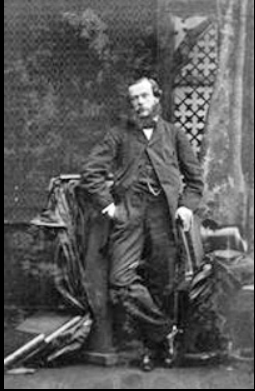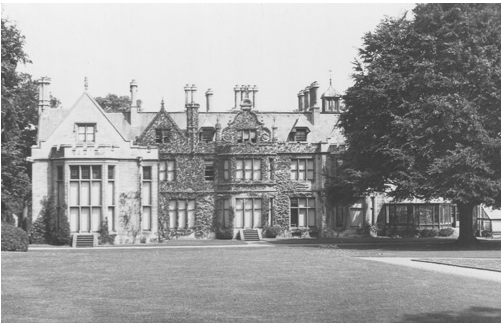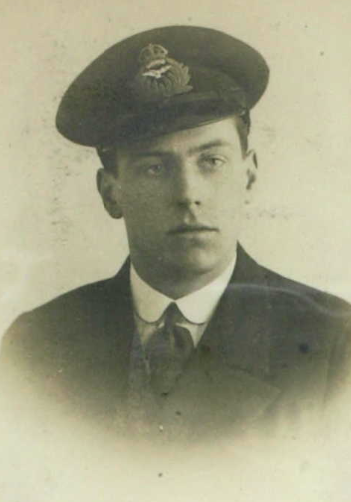Fact file:
Matriculated: 1911
Born: 10 January 1892
Died: 14 July 1916
Regiment: Leicestershire Regiment
Grave/Memorial: Thiepval Memorial: Pier and Face 2C and 3A
Family background
b. 10 January 1892 at Cottesmore Rectory, Oakham, Rutland, as the third of the six sons of the Reverend Charles Edward Ellwood (1843–1927) and Mary Katherine Ellwood (née Hopwood) (1862–1950) (m. 1888). At the time of the 1901 Census the family were living in Cottesmore Rectory (seven servants) and in 1911 at the same address (four servants); Mary Katherine later lived in Oving, Chichester, West Sussex.
Parents and antecedents
Ellwood’s paternal grandfather was William Ellwood (1797–1875), Vicar of Hargrave in Cheshire from 1839 until his death in Chester Asylum in January 1875. Ellwood’s father was the youngest of nine surviving children and was ordained deacon in 1875 and priest in 1876. After serving in five curacies from 1875 to 1888, the year in which he married, he spent the rest of his life as Rector of Cottesmore, Rutland, a village with a population of 530, in the gift of the Earl of Gaisborough. His wife and surviving sons provided a new reredos in Cottesmore Parish Church as a memorial to the 38 years Charles Ellwood served in the parish. The memorial was dedicated by his oldest son, Reverend Charles John Ellwood (1889–1969), Rector of Milton Abbas.
Ellwood’s maternal grandfather was John Turner Hopwood (1829–1900), who took his BA from Trinity College, Oxford, in 1854, the same year he was called to the bar at Middle Temple. He was the grandson of Robert [I] Hopwood (1771–1853), the founder of the Nova Scotia Mills in Blackburn and one of the wealthiest local magnates. His son, also Robert [II] (1800–1860), managed Robert Hopwood and Sons, Nova Scotia Mills, and bought Bracewell Hall. On John Turner’s coming of age in 1850 his father hired a railway train to take all 1400 of the hands at Hopwood Mills to Liverpool, “a day’s pay being allowed in each case”. Although a member of a wealthy family of cotton spinners and manufacturers, and the only son of Robert [II], John Turner Hopwood did not go into the family firm but was a partner in the music publishers Ascherberg, Hopwood and Crew Ltd, which amongst other things (although after his death) published in 1914 the song by a Magdalen chorister, David Ivor Davies (Ivor Novello) (1893–1951), ‘Keep the Home Fires Burning’. He was a Conservative politician and MP for Clitheroe 1857–1865. He inherited Bracewell Hall from his father, but in 1873 he bought Ketton Hall, Rutland, which had recently been rebuilt in the Tudor style. In 1877 he was appointed Sheriff of Rutland. At the time of the 1881 census he was living there with his wife, seven children and 15 servants.
Through his musical acquaintances, Hopwood met the well-known French organ builder Astride Cavaillé-Coll (1811–99) and in 1868 he commissioned an organ for his Bracewell home, which was inaugurated on 7 November 1870. But before the organ left Paris one of the first to play on it was Camille Saint-Saëns (1836–1921). When he moved to Ketton Hall the organ moved with him and when Ketton Hall was demolished the organ was rebuilt in Parr Hall, Warrington. On his death he left £55,053 19s. 7d. One of his sons, Rear Admiral Ronald Arthur Hopwood (1868–1949), wrote the poem The Laws of the Navy (c.1900), which according to Time magazine (1941) “takes precedence among Navy men even over Kipling’s If, [and] hangs embellished in most officers’ messes”.
Siblings and their families
Brother of:
(1) Charles John (1889–1969); married (1925) Muriel Margaret Suddaby (1904–94); three sons;
(2) Hew Gilbert Coventry (b. 1890, d. probably in Canada or Selangor, Malaya); married (1938, in Kuala Lumpur, Malaya) Nora Ann Nelson;
(3) William James Howard (later MC) (1893–1982); married (1924) Evelyn Vardon Ross (1902–97), the daughter of a Montreal banker; one son, one daughter;
(4) Michael Oliver Dundas (later DSO) (1894–1984);
(5) Aubrey Beauclerk (later Air Marshal Sir, KCB DSC DL) (1897–1992); married (1919 in India) Lesley Mary Joan Matthews (1898–1982); two sons, one daughter.
All five of Ellwood’s brothers saw active service in World War One and survived.
Charles John went to Marlborough College on a Foundation Scholarship (1903) and later studied at Keble College, Oxford (BA 1911; MA 1915). He was ordained deacon in 1914 and priest in 1915, and held various curacies from 1914 to 1925. During the war he was an Army Chaplain, and served with the Russian Armoured Car Division, Royal Naval Air Service (RNAS), from December 1915 to February 1918. After the war he resumed his work as a clergyman: he war Vicar of Stainland, West Yorkshire, from 1925 to 1927 and then became Vicar of Milton Abbas, Dorset, a living worth £501 p.a. and the cure of 771 souls, and he resigned as Rector of Binfield, Oxfordshire, in 1960.
Hew Gilbert Coventry began the war as a Private in the 10th Battalion, the Royal Fusiliers, known generally as “The Stockbrokers” because so many of its men were recruited in the City of London, and disembarked in France with that Battalion on 31 July 1915. He was finally commissioned Second Lieutenant in the 6th Battalion, The Rifle Brigade, on 1 March 1917 and confirmed as a Lieutenant in the Special Reserve of Officers on 30 June 1920. After the war he was an accountant and worked for the P[eninsular] & O[riental] Banking Corporation in Karachi. Founded in May 1920 with an authorized capital of £5 million in shares, the Bank had the largest issued capital of all the recently established foreign trade banks, and it was particularly interested in effecting better credit facilities in that part of the Empire. By the 1940s he seems to have married and to have been living in Quebec Province, in Chambly-Richelieu and near Granby.
William James Howard emigrated to Canada. He served as a Lieutenant in the Canadian Field Artillery and was awarded an MC for ‘gallantry and devotion to duty as a liaison officer with an infantry battalion during an attack’ (LG: no. 30,563 [5 March 1918], p. 2,947). After the war he became an investment banker with the Royal Bank of Montreal.
Michael Oliver Dundas was educated at Cheam Preparatory School (see below), Osborne Royal Naval College on the Isle of Wight, where he was a contemporary of the future Edward VIII (Magdalen 1912–14), and Dartmouth. He was an Acting Sub-Lieutenant in August 1914 and during the war he served on the pre-Dreadnought battleship HMS Britannia (1904; torpedoed on 9 November 1918 off Cape Trafalgar by UB50 while en route to Gibraltar, with the loss of 50 lives); on HMS Dreadnought, the flagship of the Home Fleet (1906; scrapped 1921); and, from December 1916 to 1922, the armoured cruiser HMS King Alfred (1901; scrapped 1920) as Flag Lieutenant to Rear-Admiral Sir Thomas Dawson Lees Sheppard (1866–1953), who commanded the 9th Cruiser Squadron from December 1916 to January 1919. So it is almost certain that he took no part in the Battle of Jutland (see G.M. Johnson).
From 1922 to 1924 Michael Oliver was Flag Lieutenant to Admiral Sir Michael Robeck (1862–1928) and from 1924 to 1931 he had other sea-going and shore-based appointments, rising to the rank of Commander on 30 June 1930, when he was Executive Officer on HMS Calliope (1884; scrapped 1951), one of the last two sailing corvettes built for the Royal Navy. From 1931 to 1932 he commanded the ‘S’ class destroyer HMS Searcher (1918; sold 1938) and the Gibraltar Local Command Flotilla, and he spent his last two years in the peacetime Navy as Maintenance Commander on the staff of the Commander-in-Chief at the Nore. He retired on his own request on 7 June 1934, played a lot of cricket, and returned to the Navy as Captain (13 July 1939) just before the outbreak of war. From 1939 to March 1943 he served in various sea-going and shore-based capacities and was awarded the DSO on 16 August 1940 for his part in the Dunkirk evacuation (LG: no. 34,925 [16 August 1940], p. 5,064). From March 1943 until July 1945 he was an administrator in West Africa and from August 1945 until his second retirement in September 1946 he was Officer Commanding HMS Nuthatch, the Royal Naval air station at Anthorn, Cumbria. He last saw service as a reservist in 1952.
Aubrey Beauclerk was also educated at Marlborough College and was commissioned Flight Sub-Lieutenant in the RNAS on 28 June 1916. He learnt to fly at RNAS Chingford, Essex, before being posted to 3 Squadron RNAS (203 Squadron Royal Air Force from April 1918) in February 1917, where he flew Sopwith Pups and Camels. By the time he left the Squadron he had become a double ace, with 10 confirmed kills, and on 26 April 1918 he was awarded the DSC for his “determination and skill as a pilot” (LG: no. 30,654 [23 April 1918], p. 5,060). In 1919, he became one of the first men to be awarded a permanent commission in the RAF and he served in various squadrons, mainly in India, until 1937. In 1930–31 he attended Staff College as a Squadron-Leader and in 1937 the Imperial Defence College as a Wing Commander. Thereafter he rose through the ranks in senior administrative posts until he became Acting Air Marshal on 8 October 1947 (confirmed 1 July 1947). He was made a KCB in the 1949 New Year Honours List. His last three appointments were Director-General of Personnel (1945–47), Air Officer Commanding (AOC) Bomber Command (1947–50) and AOC Transport Command (1950–52). He then became Governor and Commandant of the Church Lads’ Brigade (1954–70) and Deputy Lieutenant of Somerset (1960).
Education
Ellwood attended Cheam Preparatory School, near Epsom, Surrey, from 1902 to 1905 (cf. J.R. Platt, A.G. Kirby, L.S. Platt, A.F.C. Maclachlan, R.N.M. Bailey, E.W. Benison, C.P. Rowley). Founded in c.1645 by the Reverend George Aldrich (1574–1658), it moved to nearby Tabor House in 1719, where it stayed until 1934 when it moved to its present site at Headley, Hampshire. It was sometimes known as Manor House Preparatory School because that, according to the Censuses, was the proper name of its buildings, and sometimes, from 1856, as Mr R.S. Tabor’s Preparatory School, when the Reverend Robert Stammers Tabor (1819–1900) became its Headmaster (until 1890) and set about turning it into a purely preparatory school and, arguably, the top preparatory school in the country.
Ellwood then attended Marlborough College, Wiltshire, from 1905 to 1911, where he became a House Scholar, a Prefect, a Senior Scholar, and, finally, Head of School. He matriculated at Magdalen as an Exhibitioner in Classics on 17 October 1911 and was exempted from Responsions because he had an Oxford & Cambridge Certificate. He took the First Public Examination in the Hilary Terms of 1912 and 1913, when he was awarded a 3rd in Classical Moderations. He began reading for Classical Greats but left without taking a degree in order to join the Army. During his time at Oxford, he was awarded a Goldsmiths Scholarship. When he made his will, he gave his parents’ address: Cottesmore Rectory, Oakham, Rutland.
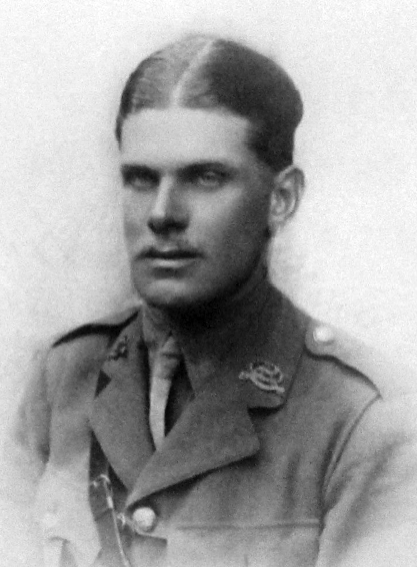
Geoffrey Thomas Lovick Ellwood
(Photo courtesy of Magdalen College, Oxford) “He was an affectionate fellow, and we had become very fond of him.”
War service
The 6th (Service) Battalion, the Leicestershire Regiment, was formed at Leicester in August 1914, and Ellwood, who was 6 foot tall, was commissioned Second Lieutenant in this Battalion on 26 August. For the next 11 months or so the Battalion trained at Aldershot and on Salisbury Plain, and it disembarked at Boulogne on 29 July 1915 as part of 110th Brigade, 37th Division. The Battalion finally arrived at Locre on 8 August and had its first experience of the trenches at Wytschaete from 9 to 11 August and near Kemmel from 15 to 17 August. It then marched to Eecke, where it stayed until 26 August, when it proceeded to Berles-au-Bois by train and on foot via Doullens and Mondicourt. From 2 until 10 September it was in the trenches opposite Monchy, probably just north of Mason, and it spent periods in and out of those trenches until 9 October, with periods in billets at Berles-au-Bois. On 20 September, the start of the Battle of Loos, it heard heavy gunfire in the direction of Arras, but took no part itself in the battle. On 9 October the Battalion moved to Humbercamp, three miles west of Berles, and stayed there until 15 October when it returned to the trenches.
But on 18 October 1915, while Ellwood was superintending wiring in front of 93A trench, a bullet struck him in the right shoulder, fracturing his 5th and 6th ribs and slightly damaging his lungs, as a result of which he had to spend the next six months recovering. He was first sent to No. 8 General Hospital, Rouen, and after preliminary treatment there he embarked for Britain on 30 October 1915. After disembarking at Southampton on the following day, he was sent to recover at the 1st Southern General Hospital, Edgbaston, Birmingham. On 23 November 1915 he was promoted Lieutenant, and on 14 December 1915 a medical board declared him fit for general service. So from 17 December 1915 until late April 1916 he served on attachment with the 10th (Reserve) Battalion of the Leicestershire Regiment at Rugeley Camp, Staffordshire.
Ellwood rejoined the 6th Battalion at the end of April 1916, when it was in billets at Mondicourt, about six miles east-north-east of Doullens, training and taking part in working parties. On 2 May it marched about six miles north-east to billets in Saulty, where it trained until 13 May. The Battalion spent from 14 to 26 May in the trenches near Hannescamps, some seven miles to the south-east, where it dug saps and suffered casualties because of heavy fire from Minenwerfer, artillery and machine-guns. It then withdrew eight miles north-west to camp at Bavincourt and stayed there until 6 June, when it returned to Hannescamps for a relatively quiet 12-day stint in the nearby trenches. The Battalion spent the rest of June 1916 back in camp at Bavincourt, training and working on fatigues, but on 1 July 1916, the opening day of the Battle of the Somme, it moved six miles south to Souastre in order to form part of the Reserve for VII Corps. For the next four days the 6th Battalion rested at Humbercamps, about three miles to the north, but on 6 July it was transferred from the 37th to the 21st Division, marched 17 miles south-westwards via Talmas to Hangest-sur-Somme, ten miles north-west of Amiens, from where it was taken by train eastwards, to the vicinity of Fricourt, three miles east of Albert, in preparation for the big attack on Bazentin Ridge that was scheduled for dawn on 14 July.
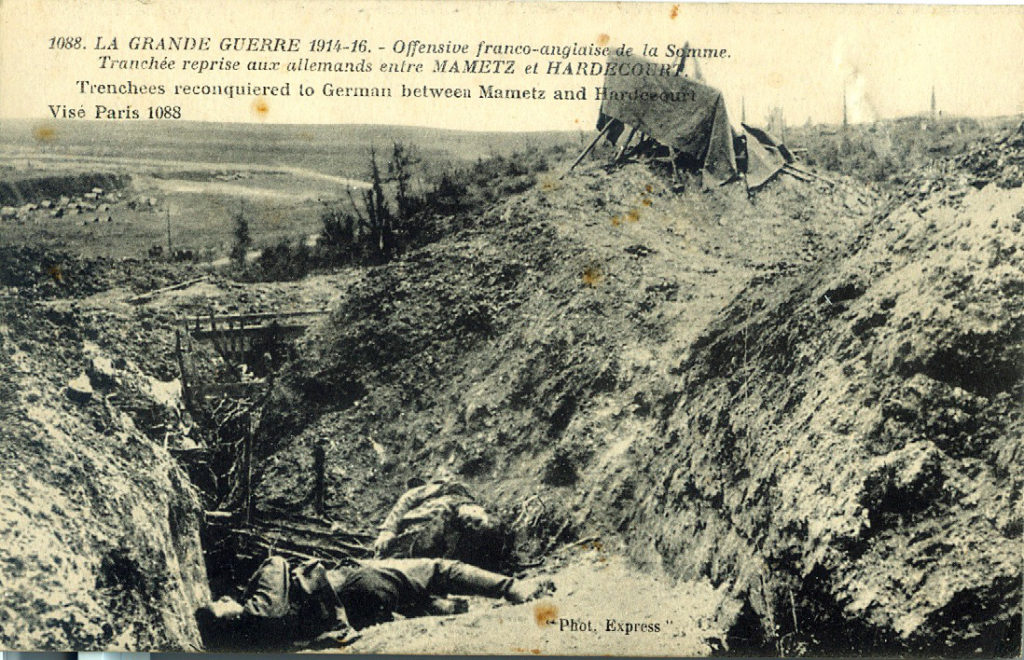
Trenches somewhere between Mametz and Hardecourt-aux-Bois, about seven miles to the east. The photo must have been taken in early July 1916, soon after the capture of Mametz by the British on 1 July 1916, the first day of the Battle of the Somme.
From 10 to 13 July the Battalion prepared itself for the attack and on the evening of 13 July ‘A’ and ‘B’ Companies were in positions along the southern end of Fricourt Wood, where they remained until midnight before moving 5,000 yards north-eastwards to the north-east corner of Mametz Wood. By 03.15 hours on 14 July 1916, Ellwood’s Battalion was formed up in four lines about 100 yards in front of Mametz Wood with orders to capture the village of Bazentin-le-Petit, a few miles north-east of Albert. Despite a fairly heavy enemy bombardment, the first and second lines moved forward at 03.25 hrs and the third and fourth lines followed them five minutes later: they took the German first and second lines without difficulty and captured 25–30 prisoners. Although many casualties were caused in the right-hand companies by machine-guns in Bazentin-le-Grand wood, the Battalion had reached the one-hour line by 04.20 hours and the two-hour line by 05.20 hours. Here it remained until 06.00 hours, when it was reinforced. Then, at 06.05 hours it moved forward once more and by 06.15 hours it had captured the village and over 200 prisoners.
Ellwood was killed in action shortly after 07.30 hours, aged 24, when his Battalion was helping the 2nd Battalion, the Royal Irish Regiment (20th Brigade, 7th Division) to consolidate their hold on Bazentin-le-Petit. He was leading his men through Bazentin Wood. But the Germans counter attacked the northern end of the village at 08.30 hours and recaptured it by 09.15 hours. In June 1916 the Battalion had numbered 32 officers and 892 other ranks: during the fighting of 14–17 July 1916 it lost 7 officers killed, 20 wounded and 500 other ranks killed, wounded and missing. Ellwood has no known grave; he is commemorated on Pier and Face 2C and 3A, Thiepval Memorial. On 28 July 1916, C.C.J. Webb registered “the sad news of Geoffrey Ellwood’s death at the front” in his Diary, commenting: “He was an affectionate fellow, and we had become very fond of him.” Although he died intestate, Ellwood’s estate amounted to £233 0s 2d.
Bibliography
For the books and archives referred to here in short form, refer to the Slow Dusk Bibliography and Archival Sources.
Printed sources:
[Anon.], ‘Lieutenant Geoffrey Thomas Lovick (“Gussie”) Ellwood’ [obituary], The Times, no. 41,231 (28 July 1916), p. 11.
[Anon.], ‘News from the Villages: Cottesmore: Lieut. T. E. L. [sic] Ellwood killed in action ….’ [brief obituary], The Lincoln, Rutland and Stamford Mercury, no. 11,185 (4 August 1916), p. 2.
‘Britain’s Roll of Honoured Dead’, in The War Illustrated, 5, no. 107 (2 September 1916), p. 2 [photo].
[Anon], World War: Debutantes Celebrated, Time Vol. XXXVII no. 1 (6 January 1941).
[Anon.], ‘Gibraltar Flotilla Command’, The Times, no. 46,009 (18 December 1931), p. 6.
[Anon.], ‘Chatham Staff Change’, The Times, no. 46,450 (22 May 1933), p. 7.
Edward Peel, Cheam School from 1645 (Gloucester: The Thornhill Press, 1974), passim.
Gerald Sumner, ‘The French Influence on High Victorian Lancashire’, BIOS XVIII p. 108.
Leinster-Mackay (1984), pp. 29, 40-2, 107, 114, 135.
McCarthy (1998), p. 48.
Archival sources:
MCA: Ms. 876 (III), vol. 1.
OUA: UR 2/1/74.
OUA (DWM): C. C. J. Webb, Diaries, MS. Eng. misc. e. 1161.
WO95/2164/1.
WO95/2530.
WO339/11519.
On-line sources:
‘Royal Navy (RN) Officers 1939-1945 E’, web-site on line.
